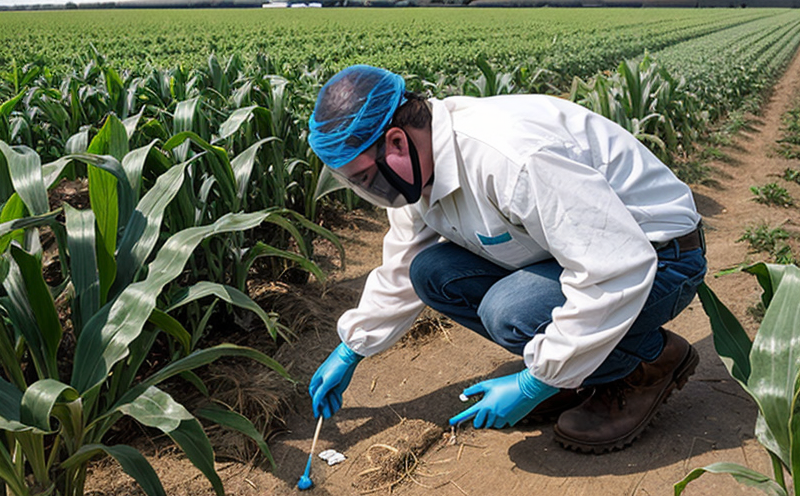Diazinon Residue Testing in Crops
Testing for diazinon residues in crops is a crucial step in ensuring food safety and regulatory compliance. Diazinon, an organophosphate insecticide, was widely used due to its broad-spectrum effectiveness against various insects. However, it has been banned or restricted in many countries because of its high toxicity to humans and the environment. Therefore, accurate residue testing ensures that crops do not exceed permissible levels set by regulatory bodies.
The process involves several steps from sample collection to final analysis. Samples are typically collected at harvest time when residues are expected to be highest. Proper sampling protocols are critical in ensuring representative samples. After collection, samples undergo initial processing which may include washing and drying depending on the type of crop. The processed samples then proceed to extraction methods such as solvent-based extraction or ultrasound-assisted extraction.
Once extracted, the sample is subjected to instrumental analysis using techniques like gas chromatography coupled with mass spectrometry (GC-MS) for precise quantification. This method ensures high sensitivity and specificity necessary for detecting even trace amounts of diazinon residues. The entire process must adhere to strict international standards such as ISO 18567, which provides guidelines on pesticide residue analysis in food.
Accurate residue testing is vital not only from an agricultural standpoint but also for consumer health protection. Regulatory agencies like the Food and Drug Administration (FDA) have set Maximum Residue Limits (MRLs) to ensure that residues do not pose a risk to public health. Compliance with these limits helps maintain trust in the food supply chain.
Technological advancements have significantly improved testing efficiency. Modern GC-MS systems provide faster turnaround times and higher resolution spectra, enhancing both accuracy and reliability of results. Furthermore, automated sample handling systems reduce human error while increasing throughput capacity.
The importance of diazinon residue testing extends beyond just compliance; it plays a role in sustainable agriculture practices by helping farmers make informed decisions about pesticide use. By monitoring residues regularly, they can adopt safer alternatives or adjust application rates accordingly to stay within legal limits.
Scope and Methodology
The scope of diazinon residue testing includes the identification, quantification, and confirmation of diazinon residues in various crops such as fruits, vegetables, grains, nuts, etc. This service employs advanced chromatographic techniques to achieve accurate measurements.
- Pesticide Residue Testing: Identification of diazinon residues
- Quantitative Analysis: Measurement of diazinon concentrations in parts per million (ppm)
- Confirmation: Verification using specific mass spectral signatures unique to diazinon
The methodology follows international standards such as ISO 18567 for pesticide residue analysis. It involves several key steps starting with sample preparation where crops are cleaned, dried, and ground into fine powder if necessary. Extraction methods vary based on crop type but generally involve using appropriate solvents like acetone or methanol.
Post-extraction, samples undergo purification processes to remove interfering compounds before injection into the GC-MS instrument for final analysis. This ensures that only diazinon components are detected during the chromatographic separation process followed by mass spectrometry for identification and quantification purposes.
Why Choose This Test
- Regulatory Compliance: Ensures adherence to local, national, and international regulations regarding pesticide residue limits in food products.
- Consumer Safety: Protects public health by ensuring that residues do not exceed safe levels set by authorities like the FDA.
- Sustainable Agriculture Practices: Helps farmers adopt safer alternatives or adjust application rates to maintain compliance while promoting sustainable farming methods.
- Precision and Reliability: Utilizes advanced chromatographic techniques providing accurate measurements down to parts per million ensuring reliable results every time.
Choosing this service means staying ahead of changing regulations, maintaining a reputable brand image, and contributing positively towards environmental conservation efforts through responsible pesticide use practices.
Customer Impact and Satisfaction
Implementing regular diazinon residue testing benefits all stakeholders involved in the agricultural supply chain. For farmers, it allows them to monitor their practices closely ensuring they comply with strict regulations without compromising yield or quality.
- Enhanced Brand Reputation: Providing transparent information about pesticide usage builds trust among consumers and retailers alike.
- Informed Decision Making: Real-time data helps farmers make educated choices regarding pesticide applications leading to improved crop yields over time.
- Legal Protection: Avoid potential legal issues arising from non-compliance with regulatory requirements thereby protecting businesses against financial penalties.
Customers who opt for this service experience peace of mind knowing that they are purchasing produce that meets stringent quality standards. This ultimately translates into higher customer satisfaction levels and stronger brand loyalty.





